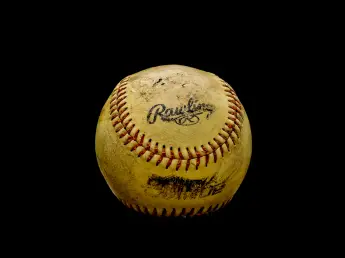If you are someone who likes baseball or plays or maybe managing the game now in other to help your preteen or teenage sons, you might know the rules, techniques, and great players in baseball history but might not have given much thought to the weight of a baseball.
There is no actual standardized size or weight of a baseball, and it depends on whether a ball used by kids or adults could also impact its weight or size.
How Heavy is a Baseball?
As stated in the official MLB rules, a baseball in major leagues should weigh from 5 to 5 1⁄4(142g and 149 g) with a circumference of 9 to 9 1⁄4 inches and diameter of 2 7⁄8–3 inches while little baseball because of small players with less energy weigh between 4 to 5 ounces.
For more information about baseball, you can check out; Baseball
Specifications of an MLB Baseball
Rawlings produced MLB baseball in Costa Rica, containing a rubber-coated center wrapped around thick layers. The outer ball shell is made of cowhide surrounded by 108 double stitches. Fascinatingly, it was done manually.
However, an effort has been put into automating baseball’s production process; unfortunately, it failed. You should also note that the materials used to make the yarn and pattern affect the aerodynamics.
History of Baseball

Since the beginning of baseball in the mid-1800s, it has gone through four stages of development: the dead-ball era, the live-ball era, world war two, and after world war.
According to baseball lore, Ellis Drake, the son of a shoemaker, was the first to introduce the baseball design that resembled the baseball used today.
Dead Ball Era
In the early era of the dead ball, baseballs were designed with different materials, often by pitchers, so no baseballs were the same in both weight and size.
When the national league was established in 1876, A.G. Spalding, a pitcher, created a ball with a core of rubber as its center. His baseball was approved by the national league and was to be used in the official league.
Before the game rules were changed in 1920, baseball could be played entirely using the same ball, even after a home run. Only when it became incomparable was it changed. Hence the ball will get dirtier, making it hard to see.
As the game progressed, the ball’s physical wear resulted in its elastic properties being reduced, stopping players from hitting for distance. Thus, giving pitchers an advantage over batters.
Live Ball Era
In 1920, Australian wool that wraps around baseball cores was used by Mr. Spalding. The new ball instantly gave the advantage back to batters.
After the Australian yarn ball was introduced, seasons experienced an increase in hits, home runs, and a popular trend towards a more offensive game.
In the same year, rules were put in place that outlawed spitballing, and balls that got soft during the game were replaced, thus putting the advantage more in the batters’ hands and frustrating the pitchers even more.
Players like the legendary Lou Gehrig were smashing it all over the place in this era.
In 1934, the American league with the national league decided to standardize this ball’s manufacturing process.
World War II-Era
During the war, many talented players in major league baseball had to leave and join the military, leading people to pay less attention to what happened to the ball.
Rubber is an important material used to make a baseball. Still, America was short on rubber because of the war that was going on because it was an essential ingredient for arms and ammunition, leading to rubber being limited to things unrelated to the war, including baseball.
A baseball was without a top-grade cork core nor a rubber mixture in wartime, but a coarse cork core was used instead. The two shells that wrap the core are made from a rubber-like substance named “Balata.”
The ball continued to go through changes even at the start of the 1943 season. In 1944, states started producing synthetic rubber, and it was used in making baseballs, thus bringing baseball back to how it was before and shifting the scale back to batters.
After World War II
Since world war two ended, not much has changed in the process in which baseball is made. Major league baseball uses an identical ball created from a unique process dominated by machines and hands to ensure each baseball is identical and indistinguishable.
The way baseballs are made has roughly been the same since the live-ball era in the 1930s. Although the exact makeup went through some alterations over time, the way they are made has stayed similar enough where the pre-world war II baseball weighed between five and one-eighth ounces, and modern-day baseball weighs up to five and a quarter ounces.
Get Started with Baseball here
How Baseballs Are Made?
First Steps in Making a Baseball
A baseball-making process starts with a rubber cork core surrounded by a black rubber and red rubber layer. Then, a revolving machine is used to make the yarn.
All this is done in a temperature-controlled room to prevent the baseball from sweating or changing real baseball complexity.
Finishing Touches
When the different versions of yarn are added to the baseball, it weighs around 4 ounces. The yard will need to be separated by length and color. You add 121byards of gray wool, add 5 yards of white wool, and 150 yards of fine white cotton.
The next step is to add the horsehide, which comprises two pieces of materials, which is now rubber cemented to the ball’s yarn and rubber base.
Lastly, bright red stitches, always double stitches that amount to exactly 108 stitches, are added to the ball, and the finished copy is always about five to five and a quarter ounces.
Conclusion
Now there you have everything you need to know about the weight and size of a baseball from when it started to this present day.
If anything was to change in the future about baseball, it will probably not be its size and weight but the process in which it is made.
For more information on topics relating to baseball, you can check out;
What is a baseball bat’s weight?


